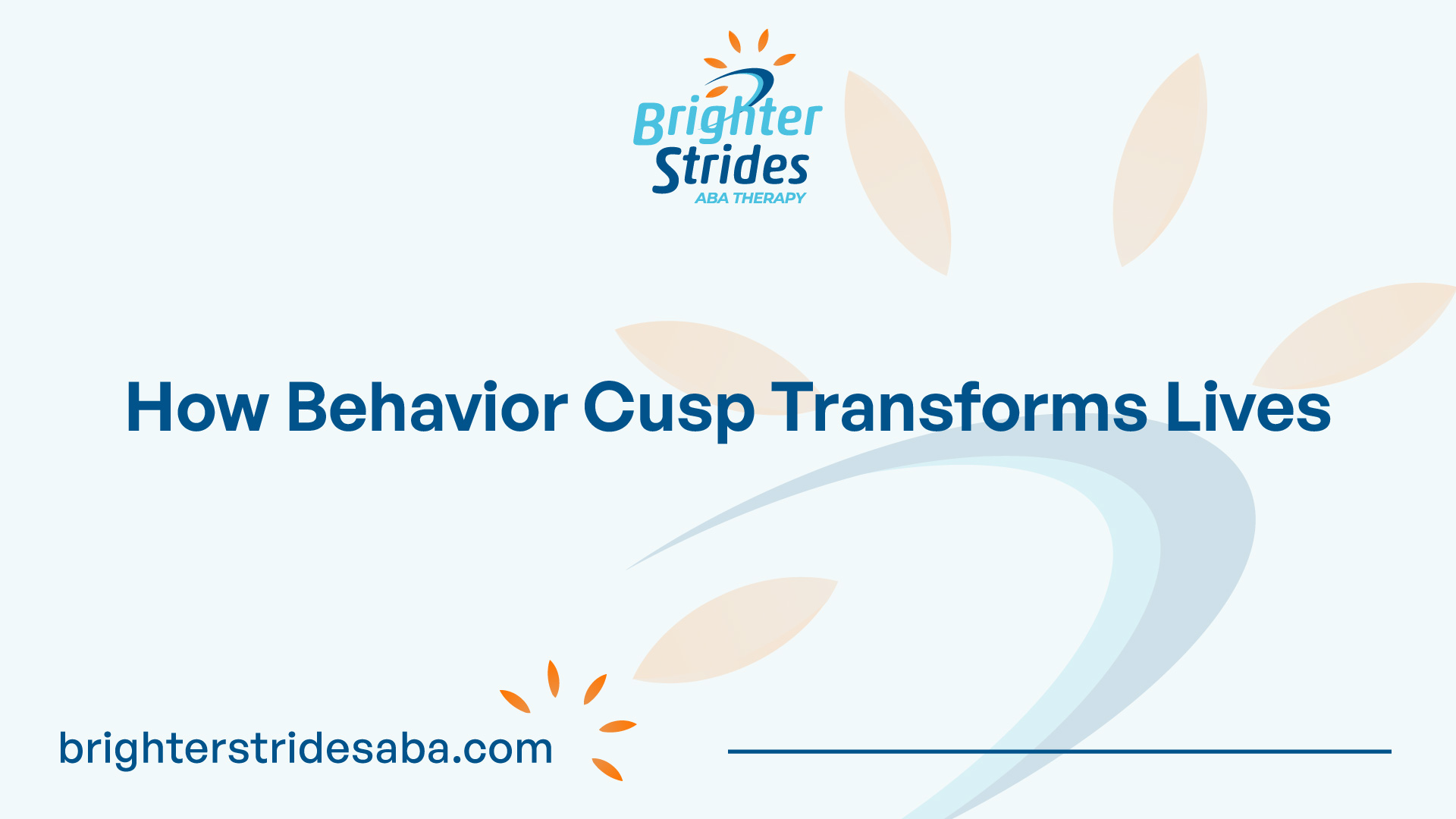Understanding Behavior Cusps
Behavior cusps are pivotal points in an individual’s behavioral development where acquiring a specific skill or behavior opens up a multitude of new opportunities and possibilities. It serves as a gateway to further skill acquisition and expands one’s repertoire of abilities. Behavior cusps are exclusively learned by children, but individuals of all ages can experience behavior cusps, sometimes without even realizing it.

Definition of Behavior Cusps
A behavior cusp refers to a behavior that, when performed, opens up the learner to a whole new world of contingencies for reinforcement and punishment that they didn’t have access to before engaging in the behavior. This behavior allows the individual to display new behaviors or generalize existing repertoires in new ways without explicit teaching. By acquiring this critical behavior, individuals gain access to new environments, social interactions, and reinforcement contingencies that were previously unavailable to them.
Implications of Behavior Cusps
Behavior cusps have several important implications, including providing valuable insights into the potential for growth and development in individuals. When behavior cusps are identified and appropriate interventions are designed, professionals can help individuals reach their full potential and lead more fulfilling lives.
Behavior cusps serve as transformative milestones in an individual’s development. Acquiring a specific skill or behavior can lead to a cascade of new behaviors, enabling individuals to engage in more complex tasks and navigate the world more independently. This expansion of abilities has a profound impact on daily functioning, often resulting in increased autonomy and improved quality of life.
By recognizing behavior cusps, professionals can identify the skills that act as the foundation for further learning and development. This understanding allows for targeted interventions and treatments that focus on fostering growth in areas with the potential for behavior cusps. The identification and support of behavior cusps can lead to breakthroughs in learning, skill acquisition, and overall development.
In summary, behavior cusps represent pivotal points in an individual’s development where acquiring specific skills or behaviors opens up new possibilities and opportunities. They serve as transformative milestones, impacting daily functioning and expanding one’s repertoire of abilities. Understanding behavior cusps allows professionals to design interventions that help individuals reach their full potential and navigate the world more independently.
Examples of Behavior Cusps
Behavior cusps are significant milestones that can have transformative effects on an individual’s life. They involve the acquisition of new skills or behaviors that open doors to new environments, opportunities, and social interactions. Here are three examples of behavior cusps:
Language Acquisition
Language acquisition is a prominent example of a behavior cusp, as it involves the transition from non-verbal communication to the development of spoken language. This milestone significantly impacts an individual’s ability to interact with others and access opportunities for learning, socialization, and self-expression.
The acquisition of language allows individuals to effectively communicate their thoughts, needs, and emotions. It enables them to engage in meaningful conversations, express themselves creatively, and participate more fully in various social and educational settings. Language acquisition opens up a world of possibilities, facilitating learning, building relationships, and contributing to overall cognitive and emotional development.
Independent Living Skills
The development of independent living skills is another example of a behavior cusp. These skills empower individuals to live more independently, make their own decisions, and participate actively in society. They include activities such as personal hygiene, cooking, cleaning, managing finances, and transportation. Mastering these skills leads to enhanced quality of life and self-determination.
By acquiring independent living skills, individuals gain the confidence and ability to take care of themselves and their surroundings. They become capable of managing their daily routines, maintaining personal hygiene, and handling various household tasks. Independent living skills promote self-sufficiency, autonomy, and a sense of empowerment, enabling individuals to lead more fulfilling and meaningful lives.
Social Interaction Skills
Social interaction skills represent another behavior cusp that, when mastered, can lead to increased self-confidence, improved social functioning, and a greater sense of belonging. These skills encompass the ability to initiate and maintain conversations, interpret non-verbal cues, and navigate social situations with ease [4].
Developing strong social interaction skills allows individuals to connect with others, establish meaningful relationships, and build a supportive network. It enhances their ability to understand and respond appropriately to social cues, fostering positive interactions and reducing social anxiety. Mastering social interaction skills opens up opportunities for meaningful social connections, enriching one’s social life and overall well-being.
By recognizing and understanding behavior cusps, individuals, caregivers, and professionals can provide the necessary support and guidance to facilitate the acquisition of these critical skills. Behavior cusps play a vital role in personal development and have a profound impact on an individual’s daily functioning and overall quality of life.
Importance in Development
Behavior cusps play a critical role in an individual’s development, marking transformative milestones that have a significant impact on their overall capabilities and functioning. Understanding the importance of behavior cusps can shed light on the profound changes they bring to an individual’s life.
Transformative Milestones
Behavior cusps are defined as pivotal points in an individual’s development where the acquisition of specific skills opens up a broader range of opportunities and capabilities. These milestones serve as a foundation for learning and become the gateway to mastering more complex abilities. By mastering behavior cusps, individuals gain the skills necessary to engage in a broader spectrum of experiences, catalyzing further learning and growth.
For example, language acquisition is a behavior cusp that enables individuals to communicate effectively and participate in various social interactions. Learning to speak opens up a world of opportunities for education, socialization, and self-expression. Similarly, acquiring independent living skills, such as personal hygiene and household chores, empowers individuals to become more self-reliant and lead a more autonomous life.
Impact on Daily Functioning
The mastery of behavior cusps has a profound impact on an individual’s daily functioning. These milestones allow individuals to navigate their environment more effectively, adapt to new situations, and engage in a wide range of activities.
For individuals with autism, behavior cusps are particularly crucial as they provide a foundation for learning and help individuals acquire the skills necessary for independent living and social interaction [3]. By targeting behavior cusps in applied behavior analysis (ABA) therapy, individuals with autism can experience substantial improvements in their adaptive skills, communication abilities, and overall quality of life.
Moreover, behavior cusps have cross-generational implications. Younger generations often teach the elderly how to use technology, a behavior cusp that enables the elderly to access new information, stay connected with loved ones, and engage in the digital world. These transformative milestones not only enhance daily functioning but also promote social inclusion and overall well-being.
Recognizing the importance of behavior cusps in development allows individuals, caregivers, and therapists to set appropriate goals and interventions that target these pivotal areas. By focusing on behavior cusps, individuals can experience comprehensive improvements across multiple areas of behavior from a single point of instruction, leading to more efficient and effective interventions [5].
Recognizing Behavior Cusps
In order to understand and support individuals in their developmental journey, it is crucial to recognize behavior cusps. Early identification of behavior cusps allows for necessary guidance and encouragement to be provided, fostering growth and development. This section will cover the importance of early identification and the support and guidance required.
Early Identification
Identifying potential behavior cusp situations early on is essential for individuals’ overall development. Recognizing the signs of a behavior cusp enables timely intervention and support. These critical points in an individual’s development can arise from any significant event that challenges existing beliefs and habits, whether positive or negative. By being aware of the potential for behavior cusps, parents, caregivers, and professionals can actively observe and assess an individual’s behavior and identify if they are on the cusp of transformative milestones.
Support and Guidance
Once a behavior cusp is recognized, providing the necessary support and guidance becomes crucial. Understanding an individual’s unique needs and abilities is essential for fostering behavior cusps, particularly in individuals with autism. Professional assessment and intervention play a vital role in identifying potential behavior cusps and providing appropriate support. By utilizing evidence-based practices and interventions, professionals can guide individuals through behavior cusps, ensuring that their growth and development are maximized.
Support and guidance during behavior cusps can encompass various strategies, including:
- Individualized Intervention: Tailoring interventions to meet the specific needs of the individual undergoing a behavior cusp.
- Targeted Skill Development: Focusing on developing specific skills that are crucial for the individual’s progress and functional independence.
- Behavior Management: Implementing strategies to address challenging behaviors and promote positive behavior change.
- Effective Communication: Encouraging open and effective communication between individuals, caregivers, and professionals to ensure a comprehensive understanding of needs, progress, and challenges.
By providing the necessary support and guidance during behavior cusps, individuals can navigate these critical points successfully and achieve meaningful outcomes in their development.
In the field of Applied Behavior Analysis (ABA), recognizing behavior cusps is of utmost importance. Behavior cusps play a significant role in setting treatment goals and designing behavior intervention plans. Identifying pivotal behaviors and behavior cusps allows practitioners to target specific areas of development that can lead to meaningful positive change. By focusing on these areas, practitioners enhance the effectiveness of interventions and promote significant progress in individuals’ overall functioning and quality of life.
Recognizing behavior cusps and providing the necessary support and guidance are essential steps in facilitating individuals’ growth and development. By understanding the significance of behavior cusps and implementing appropriate interventions, individuals can overcome challenges and reach their full potential.
Behavior Cusps in Different Scenarios
Behavior cusps can have a transformative impact on individuals across various scenarios and stages of life. Two notable examples where behavior cusps play a significant role are technology utilization and elderly learning new skills.
Technology Utilization
Teaching older individuals how to use technology, such as smartphones and tablets, can be a behavior cusp that opens up a world of possibilities. This newfound knowledge grants them access to their children and loved ones in ways they may have never dreamt possible in years past. Younger generations often play a crucial role in teaching the elderly how to navigate and utilize these technological devices. By acquiring technology skills, the elderly gain independence, improved communication, and the ability to access information and services readily available online. It can greatly enhance their quality of life and bridge the digital divide.
Elderly Learning New Skills
Behavior cusps are not limited to children; almost anyone can experience new insights and growth through them, sometimes without even realizing it. The elderly learning new skills represents another example of behavior cusps in action. As individuals age, acquiring new skills can have profound impacts on their daily lives and overall well-being. Learning new skills, such as mastering a musical instrument, picking up a new hobby, or developing proficiency in a foreign language, can provide intellectual stimulation, promote cognitive health, and enhance social connections. These behavior cusps can lead to increased confidence, self-esteem, and a sense of accomplishment.
By recognizing the potential behavior cusps in different scenarios, we can better understand their transformative power and tap into their benefits. Whether it is embracing technology to connect generations or empowering the elderly to learn and grow, behavior cusps have the ability to unlock new opportunities and enrich lives.
Behavior Cusps in Applied Behavior Analysis (ABA)
Applied Behavior Analysis (ABA) is a therapeutic approach that focuses on understanding and modifying behavior to improve individuals’ lives. Behavior cusps play a crucial role in ABA therapy as they act as pivotal behaviors that open up new environments and learning opportunities, serving as gateways to further development. By incorporating behavior cusps into treatment goals, individuals can engage in a broader spectrum of experiences, catalyzing further learning and growth.
Role in ABA Therapy
Behavior cusps are instrumental in ABA therapy as they represent behaviors that, once acquired, initiate a wide range of other positive behaviors. By targeting behavior cusps, practitioners enhance the effectiveness of interventions, leading to significant positive changes across multiple areas of behavior from a single point of instruction.
ABA therapists identify behavior cusps by conducting accurate assessments, which are foundational in setting individualized treatment goals. Functional assessments help to understand the relationship between a behavior and its environment, determining why a behavior is occurring. This knowledge is crucial to address the behavior effectively and develop targeted interventions.
By designing behavior intervention plans that incorporate behavior cusps, practitioners ensure that interventions align with evidence-based practices and yield meaningful outcomes. The identification of pivotal behaviors and behavior cusps, along with consistent evaluation of their impact on individuals’ quality of life and social acceptance, enhances the efficiency and efficacy of ABA interventions.
Setting Treatment Goals
In ABA therapy, setting individualized treatment goals is essential for guiding interventions and tracking progress. Identifying behavior cusps helps practitioners identify pivotal areas for development and target them effectively. By focusing on behavior cusps, therapists can maximize the impact of interventions, leading to comprehensive improvements across various areas of behavior.
Setting treatment goals for behavior cusps involves a collaborative process between the therapist, individual, and their caregivers. It requires a thorough understanding of the individual’s strengths, challenges, and desired outcomes. By incorporating behavior cusps into treatment goals, ABA therapists can create interventions that have a meaningful and lasting impact on an individual’s development and overall well-being.
In conclusion, behavior cusps play a crucial role in ABA therapy. By targeting these pivotal behaviors, therapists enhance the effectiveness of interventions, leading to comprehensive improvements across various areas of behavior. The identification and incorporation of behavior cusps into treatment goals ensures that interventions align with evidence-based practices and yield meaningful outcomes, promoting positive change and growth in individuals undergoing ABA therapy.
References
- https://www.studynotesaba.com/glossary/behavior-cusp/
- https://www.abtaba.com/blog/behavior-cusp
- https://www.supportivecareaba.com/aba-therapy/behavior-cusp
- https://www.adinaaba.com/post/behavior-cusps
- https://masteraba.com/importance-of-targeting-pivotal-behaviors-and-behavior-cusps-when-identifying-goals-for-behavior-intervention-plans-in-aba/
- https://www.crossrivertherapy.com/aba-therapists/behavior-cusp

 We've just released an article!
Check out our blog!
We've just released an article!
Check out our blog!



